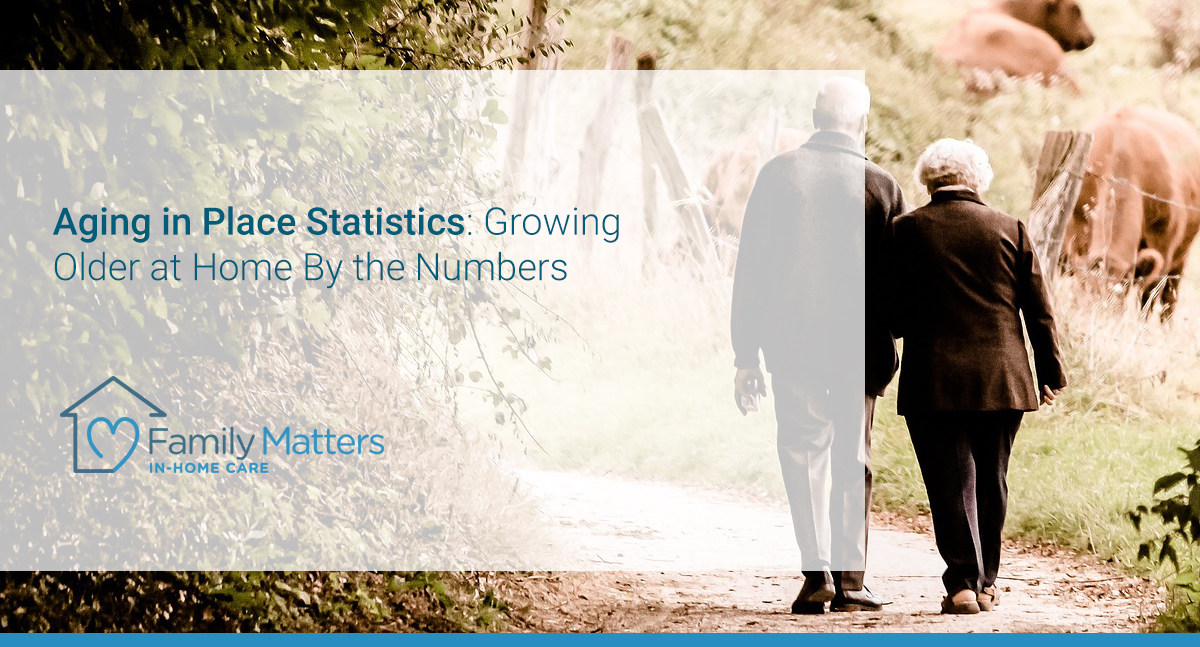
Aging in Place Statistics: Growing Older at Home by the Numbers
What does it mean to age in place? The answer depends on who you ask. Some organizations and people might say it’s growing old safely and comfortably in any home environment. Others say that it’s remaining in a person’s same home their entire lives, even as they become elderly.
People generally agree that aging in place is to remain in a person’s own residence of choice as they age for as long as they can do so safely. The benefits of doing so cannot be underestimated.
Research has shown those who age in place heal more quickly from illness and recover quicker after surgery, maintain their independence longer, and have an overall higher quality of life.
Aging in Place Depends on Safety
A key part of aging in place is safety. A person must be safe and healthy in their home to remain there. If you have a loved one who wants to remain at home as they age, there are some things you can do to help them stay safe:
- Install a shower bench or chair
- Install grab bars where needed
- Ensure no cords are trip hazards
- Remove area rugs or secure them to the floor
- Place a lamp at their bedside
- Ensure areas of the home are well-lit
- Ensure all floors are clutter-free
There is much to think about when it comes to helping a loved one who wants to remain at home. Aging in place statistics show that over 75% of adults who are at least 50 years of age report that they want to remain in their homes for as long as possible, according to a 2021 AARP poll.
The University of Michigan National Poll on Healthy Aging had somewhat similar results, reporting that 88% of adults feel it’s important to age in place.
Many People Are Not Yet Prepared to Age in Place
Many people who want to remain in their homes for the duration of their lives may not be entirely prepared to do so.
Aging in place statistics reveal that almost 80% of people who want to stay in their homes would need to modify their bathrooms, and over 70% of people have accessibility issues with the interior and exterior of their homes.
Furthermore, almost half of the polled adults want smart home devices installed, and over 60% want some emergency alert system.
The University of Michigan poll found that only 15% of adults between the ages of 50 and 80 had given “a lot” of thought to modifications they would need to make to their homes in order to remain there. Just 38% had given “some” thought, 26% had given “little” thought to the need, and 21% had given it no thought at all.
Furthermore, just 33% of the people polled reported that their home definitely has the features they would need to age in place. Almost half of the adults (47%) said their home “probably” does, and 19% reported that their home does not.
The most common home features adults cited as having in their homes that would allow them to age in place were:
- A main floor bedroom (78%)
- A main floor bathroom (88%)
- Wide door frames for wheelchairs (54%)
- Lever-style door handles (32%)
- Home entrances with ramps or no stairs (19%)
- Shower benches or chairs (36%)
- Raised toilets (36%)
- Grab bars (32%)
The bathroom is notoriously one of the most dangerous rooms in the house; more than 80% of home accidents and falls happen in the bathroom. However, only 7% of people polled by the University of Michigan stated they had barrier-free bathrooms.
Aging in Place Statistics: What About ADUs?
You may or may not be familiar with ADUs, which are accessory dwelling units. These are small home spaces located on the property of an existing home, and they are often used by adults who want to remain independent in their own space but would benefit from having loved ones nearby.
Recent aging in place statistics show that almost 50% of adults recently polled by AARP would consider an alternate living set-up like an ADU. There were three big reasons they gave:
- They would save money
- They would have support daily
- They would be near someone but retain their own living space
On the flip side, a majority (62%) of people polled said they would consider having an ADU built on their property for a family member or friend.
Social Support, Assistance, and Aging in Place
Above all else, the most important factor in being able to age in place is a person’s support system. Almost 40% of people do not know of any organizations or places that welcome older people to socialize, and over a quarter of older adults in the U.S. live alone.
Aging in place statistics show that there is still much work to be done to cultivate a culture that promotes citizens being able to remain at home safely and independently as they grow older.
If you or your family member is considering in-home care as part of a plan to age in place, contact Family Matters In-Home Care today for a free consultation. Our team is dedicated to supporting your family and helping older adults enjoy life in the comfort of their own home for as long as possible.
Some of the services offered by Family Matter In-Home Care include: Alzheimer’s & Dementia Care, Bed & Wheelchair Transfer Assistance, Companionship, Housekeeping & Meal Preparation, Personal Care, Recovery Care, and Transportation.
Serving the San Francisco Bay Area and Greater San Diego, Family Matter In-Home Care has offices throughout California including: Campbell, CA, Roseville, CA, San Marcos, CA, and San Mateo, CA.
